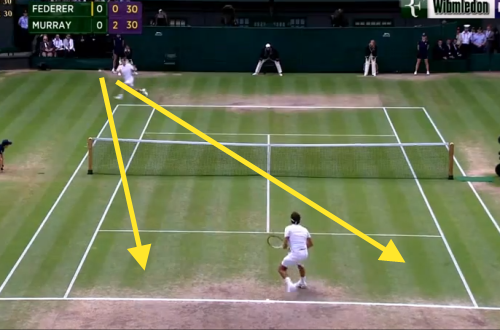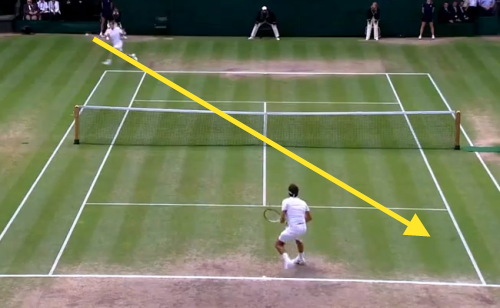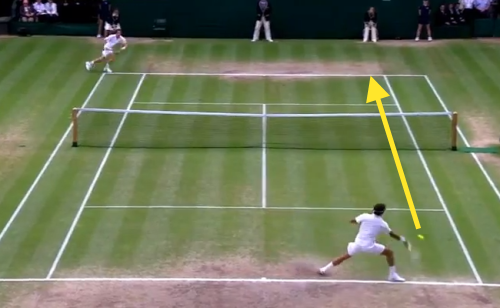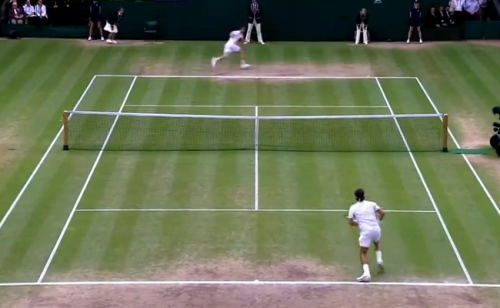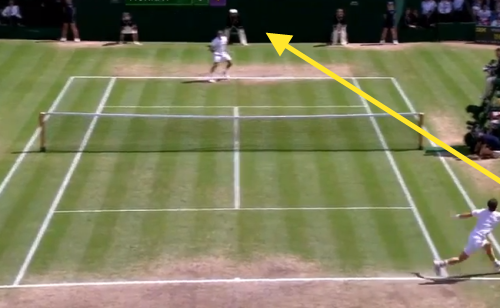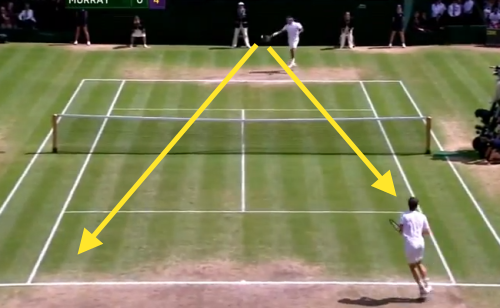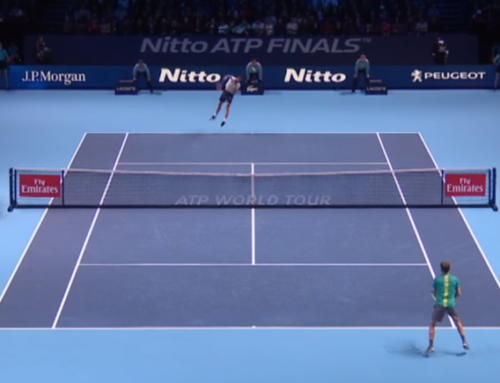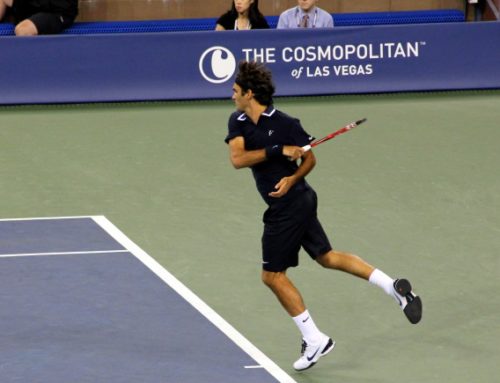When Roger Federer played Andy Murray in the Wimbledon final in 2012 he came onto the court with some very specific goals and strategies. One of these revolved around his serve location on the deuce court. Specifically he came out with the intent of serving an amazingly large percentage of his serves wide to the Murray forehand. This is nothing new – in his first round win against Paire in the Australian Open yesterday Federer put 13 serves out wide on the deuce court compared to just 2 down the middle. But it does beg the question: why does Federer put so many serves out into the forehand of his right-handed opponents on the deuce court? Today we’re going to break down exactly what Federer’s goal with this serve is, and show you how you can put it to good use in your own matches.
In this first image we can see Murray at the moment of contact while returning one of Federer’s wide serves to the deuce court in the Wimbledon final mentioned earlier. I have marked out Murray’s two real choices for the return with the arrows. The first option is for Murray to try to force his return down the line. This is low percentage return as Murray is trying to change the direction of the ball, return it into the shortest part of the court over the highest part of the net. If he wishes to make a reasonably high percentage of these returns, he must either take some pace off his shot, or direct it a little bit central to cut down the extremely likelihood of him missing the return wide. Murray’s second option is to take the return cross-court into the Federer forehand. This is obviously fraught with perils of its own, but it does give Murray more favorable angles on the return – he will both make more returns hitting in this direction and be less out of position – he forces Federer to change the direction of the ball to hit into the open court.
So let’s take a look at two sample points and see exactly how Federer handles each scenario…
The Cross-Court Return
First let’s look at the cross-court return. The advantages of taking this line on the return are it is a much higher percentage return. Hitting over the low part of the net into the longest part of the court, Murray plays himself into better position theoretically. I say theoretically because his cross-court return forces Federer to have to change the direction of the ball in order to stay on the attack. However it doesn’t take a rocket scientist to see the problem for Murray – he is far, far out of court and hitting into arguably the greatest stroke in the history of tennis.
A few important things to note in this second frame. The first is Murray’s hip position. You can see that he has turned his hips – a sure sign that he is committed move in a single direction. Players will keep their hips neutral if they are uncertain which direction they need to run. Murray has decided to run to cover the down the line forehand no matter what. In this instance he is correct, but had Federer chosen to take his forehand back cross-court, Murray would have faced difficulty stopping his run, turning around and trying to retrieve the ball.
This final image in the sequence says it all without the need for arrows. Murray has so much ground to cover that Federer instinctively knows he cannot hope to play an offensive shot off the forehand he just hit. Federer is committing himself forward in anticipation of Murray playing a weaker, defensive shot. This is an important lesson for anyone – when you have your opponent on the ropes put the pressure on them. Do not leave them an easy out! A this point plays out Murray plays a defensive lob which Federer puts away with ease.
The Down The Line Return
The players have changed ends here but we pick up with Murray trying the return down the line. As you can see, the angle of Murray’s return is somewhat back towards the center – trying to play a truly down the line return becomes a very high risk shot off such a quality serve. The other danger in doing so is it allows Federer to hit an angled cross-court backhand – a difficult ball for Murray to run down because it is traveling at a more acute angle away from him. So instead he plays the ball more centrally, which allows Federer to run around his backhand and set up a forehand instead.
Contrast the position of Murray’s hips in this image compared to the one earlier. He is remaining somewhat square to the net because he realizes that Federer has two viable options with this forehand – demonstrated by the two yellow arrows. If Murray commits himself with a hip turn, Federer can go behind him for an easy winner. Instead Murray must remain mostly neutral to try to cover both options. The problem is that also freezes him, and the indecision puts Federer firmly in control of the point. In the point shown, Federer took the ball inside out, got a short ball off which he played a dropshot and ended up with an easy overhead to win it.
How Can This Help You?
You don’t need to be able to serve the ball as wide and fast as Federer unless you are facing an opponent of Murray’s caliber. Regardless there are some central themes here that you can make use of no matter what your skill level.
1. There is value in opening up the court. Whether it is on the ad side or the deuce side, taking your opponent wide with the serve and forcing them into tough positions is a positive move. Your goal should be to give your opponent a difficult decision to make – ideally one in which none of their choices are good ones. Opening the court offensively can do this.
2. Use the likely cross-court return to set up the point. Provided your serve has enough pace for your level that your opponent can’t easily power it down the line, that is. If you can rush them, their best bet lies in the cross-court return so choose your wide serve wisely to set up your strongest shot (wide on the deuce if your forehand is strongest, wide on the ad if your backhand is strongest).
3. Don’t be afraid of their strengths. As you follow Federer’s serving patterns you quickly realize that he serves wide frequently on the deuce court against everyone, regardless of whether their forehand or backhand is stronger. This is because the value of the court position he gains from doing so outweighs any disadvantage of serving into their strength. The same can be true for you. Many right-handed players will actually move to their left to increase their odds of getting a forehand return. In doing so they make themselves more vulnerable.
4. When you find a pattern that works, stick with it. At least until it stops working! Once you get a combination that works – be it a wide serve followed by a ball into the open court, or a body serve followed by an approach shot – stick with it! You only need to do something else often enough to avoid becoming too predictable. Not just predictable, but too predictable. So long as you’re winning more points than you’re losing, you’re on the path to victory.
5. Life is uncertain. Ride your best horse first. Too often player save their strongest plays for ‘big’ or ‘important’ points. Instead, use your strong plays early and often, so that all of the big or important points are played to your advantage. Don’t wait until you’re 30-40 down to pull out your surefire play. Use it earlier to avoid ever getting to 30-40 in the first place.
